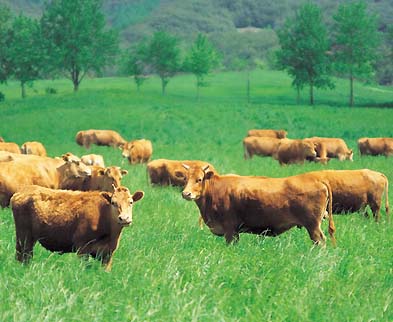Now is the Time to Stockpile Forages, Renovate Fields
Now is the Time to Stockpile Forages, Renovate Fields

Most areas of Kentucky enjoyed timely rains throughout the summer allowing for plentiful pastures. That should make it easy for producers to stockpile some of those fields now for cattle to graze in the fall and winter months, reducing hay feeding and lowering overall feed costs. Those rains should also allow for successful fall pasture renovations as well.
“Stockpiling is a very good practice,” said Garry Lacefield, Extension forage specialist with the University of Kentucky College of Agriculture. “Stockpiling tall fescue will extend pastures later into the season than any other grasses that we have and the data continues to show that everyday grazing is cheaper than feeding hay.”
More and more producers are seeing the importance of stockpiling and making more efficient use of their pastures throughout the year thanks to educational programs such as Master Cattlemen Program, grazing conferences, and the Master Grazer program,” said Ray Smith, also a forage specialist with UK.
“The interest is there,” he said. “We are moving away from tobacco first mentality and seeing the profit potential in beef cattle and are putting an effort toward that. Cattle producers in Kentucky can make some inexpensive changes that could improve the quality of their animals and the management of those animals. One of the simplest things is stockpiling. The cost of that feed is about a third of the cost of having to feed hay.”
Lacefield said for stockpiling to be most effective you must start with green, growing tissue. Fortunately, the rains have been timely this year allowing for grasses to be available for stockpiling.
“We need to be very objective about the fields we stockpile,” he said. “We know that in Kentucky we have two wonderful grasses, Kentucky bluegrass and tall fescue, that are excellent for stockpiling. It is important to graze pasture down first, then apply nitrogen (50 to 80 pounds per acre) to stimulate lush vegetative growth and stay off those fields until we essentially use up
all the other pastures. Hopefully, that will take us past Thanksgiving or even Christmas, and then we can turn the cattle into that stockpiled material.
“While nitrogen prices are higher than we’d like, our data still suggests that anything we can do to graze longer and feed less hay or silage is still economical to the beef producer,” he said. “You can get 25 pounds of dry matter for every pound of nitrogen you apply and even with nitrogen prices today that’s economical.”
Smith said it is essential to get nitrogen applied as soon as possible to get full growth potential from the forages. It is best to do it in August and each week that goes by in September before it is applied will mean less and less effectiveness from nitrogen on fall growth.
In addition to stockpiling forages for winter use, now is the time to begin pasture and hayfield renovation.
“A very good season is shaping up for renovation or re-establishment of pastures because in many parts of the state we’ve had some rains to get moisture into the soil,” Smith said. “It looks like we are in a pattern where we will continue to get moisture, which we didn’t have last fall. Last fall was a terrible time to establish.”
The month of September is a great time to get grasses started. Alfalfa seedings are recommended for late summer. August 15 is the ideal time and the later it gets into the fall the riskier it is that alfalfa will fail. Grass though can be successfully established throughout September, but earlier September is much better than later in the month. Make sure fertility and pH is where it needs to be for the crop being established. If a soil test hasn’t already been done, take one and fertilize accordingly once the seeding gets established.
“People are realizing they need to get more off of their pastures so they are trying to improve them,” Lacefield said. “Right now, we have a number of pastures and hayfields in the process of being completely re-established. The past five or six years have been conducive to weed growth.”
Principles producers need to abide by, in addition to soil testing, is to match plant species to soils, select the right varieties, planting date, seeding rate, seeding method and planting depth.
Adding clover into existing pastures is also beneficial. It will eliminate the need to add nitrogen because of its nitrogen fixation, improve the quality of the pastures, and overcome some of the cattle production problems associated with feeding endophyte-infected fescue.
UK specialists encourage producers to seed clover in February through a freeze/thaw method or in March if they are using a no-till drill. Now is the time to get fertility in order and do any weed control treatments. Herbicides applied in the fall will have no residual affect on the clover when it is seeded next spring.
Thousands of acres of Kentucky farmland are devoted to the production of pasture and hay for the state’s cattle industry. Stockpiling forages for winter feed and renovating pasture and hayfields are important parts of a successful beef cattle operation. More information on forage production can be found at county offices of the UK Cooperative Extension Service or the forages Web site.
